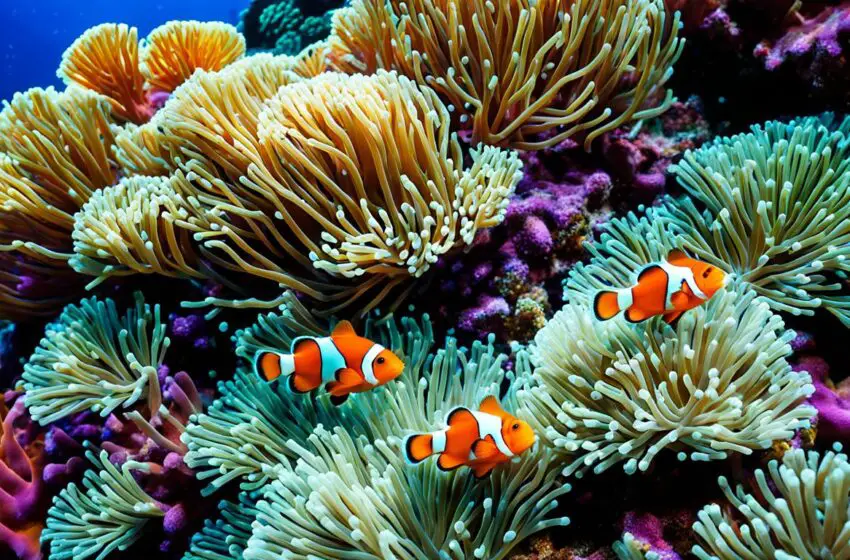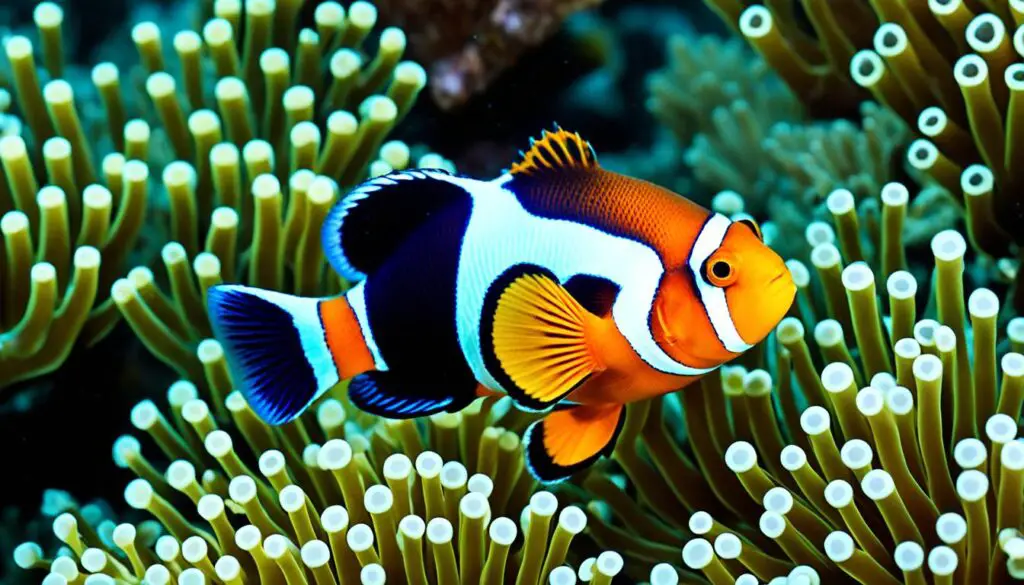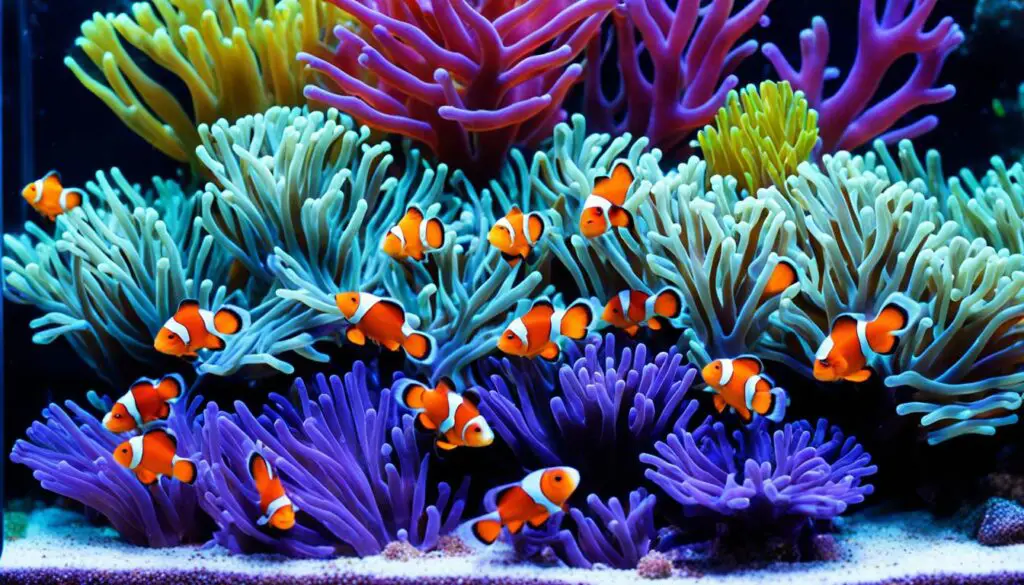Dive into Fish Care: Top Tips for Happy Clownfish

Welcome to our guide on caring for clownfish! If you love tropical fish, you’re in the right place. This article aims to boost your knowledge on how to keep these unique fish happy.
By the end, you’ll be equipped with tips and insights. You’ll know how to create the best home for your clownfish to thrive.
Key Takeaways:
- Proper salinity level (1.020-1.024) and water temperature (75-80 °F) are crucial for clownfish health.
- Feeding clownfish a varied diet, including frozen fish frenzy, mysis, and brine shrimp, ensures optimal nutrition.
- Regular water changes and vacuuming every 4 days help maintain water quality.
- Providing appropriate lighting from 7am to 7pm simulates their natural diurnal cycle.
- Ensuring adequate water flow and considering the use of thick sponges as dividers can benefit tank setup.
- Breeding clownfish requires careful attention to water parameters and proper nesting conditions.
Understanding the Natural Habitat and Behavior of Clownfish
Clownfish are fascinating to study. They live in the Eastern Indian Ocean to the Western Pacific. This includes the famous ocellaris clownfish. They make shallow reefs and lagoons their homes, not going deeper than 50 feet.
Clownfish are unique because they live with sea anemones. These anemones protect them and give them food. It’s a helpful relationship. The anemones keep them safe, and the fish bring them scraps.
The ocellaris clownfish likes to be with specific sea anemones. These are Heteractis magnifica, Stichodactyla mertensii, and Stichodactyla gigantea. Each kind of anemone provides a special place for them to live safely.
Clownfish have an interesting social life, too. There is always a leading pair in their group. They are in charge of making babies. The other fish are mostly males, who are not ready to have babies. The youngsters are at the bottom and might get chased by the older fish.
Learning about clownfish’s home and behavior gives us a look into their world. It is a wild place where they fit in so many unique ways. This helps us understand and care for them better, whether in the ocean or our aquariums.

Range of Clownfish
Clownfish live in the Eastern Indian Ocean and the Western Pacific. They are often seen in hot waters, like in Indonesia and the Great Barrier Reef. Their love for both shallow regions and lagoons shows how they can live in many different places.
The Description and Compatibility of Ocellaris Clownfish
Ocellaris clownfish, known as false clownfish, are beautiful and friendly fish perfect for aquariums. They have a vibrant orange color with white stripes and black edges on their fins. This makes the aquarium look lively.
These clownfish can grow up to 4.3″ long, with females usually bigger than males. They are often confused with percula clownfish, but their habits and where they live are different.
Ocellaris clownfish work well in small tanks. But, a 20-gallon tank is better for their health and freedom to move. This ensures they are happy and healthy.
They are happier with a companion, and watching them together is interesting. Their playful behavior lightens up the aquarium.
It’s important to choose suitable friends for the ocellaris clownfish in the tank. Pick fish that are small and peaceful, like gobies and blennies. Adding invertebrates such as cleaner shrimp and snails can also make the tank more fun.
Benefits of Keeping Ocellaris Clownfish in Nano Aquariums
Nano aquariums are great for ocellaris clownfish. They’re simpler to care for, need less room, and use less power. They’re perfect for anyone wanting a small but engaging aquatic display.
With nano aquariums, you get to be creative with the design. It’s easy to make an attractive home for the clownfish and their friends.
Aquarium Compatibility: Ensuring a Reef-Safe Environment
When picking friends for ocellaris clownfish, focus on reef safety. These clownfish will not harm the corals and other sea life in a reef tank.
Choosing the right fish and invertebrates means your tank will be peaceful and healthy. Cleaner shrimp, snails, and small colorful fish are good choices.
Adding ocellaris clownfish brings color and fun to your aquarium. They look stunning and are a great fit for small tanks. Anyone, from beginners to experts, will enjoy having them.

Conclusion
Looking after ocellaris clownfish needs close attention. To keep them healthy, you must get the aquarium conditions just right. This means having the right salt level, temperature, and giving them a mix of food. Also, make sure their home has the correct light and water. And pick other fish that get along with them.
If you want to breed ocellaris clownfish, it can be very satisfying. But it’s important to set up the perfect spot for them to lay their eggs. Giving them a great place to spawn will let you enjoy watching the baby fish grow.
Ocellaris clownfish thrive when they’re cared for properly. They can even live over 20 years. Their bright colors and fun habits make them a great choice for your tank. If you’re thinking about getting these fish, make sure you have the best home for them. Then, enjoy the happiness they can bring.
FAQ
What salinity level should I maintain in my aquarium for clownfish care?
For the best care, keep the saltwater in your aquarium between 1.020 and 1.024.
What is the optimal water temperature for clownfish?
Keep the water temperature between 75 and 80 °F for the health of your clownfish.
What should I feed my clownfish?
Give clownfish a mix of foods. Try frozen fish frenzy, mysis, and brine shrimp.
How often should I perform water changes for clownfish care?
Change the water and vacuum every 4 days to keep the clownfish healthy.
What kind of lighting should I provide for clownfish?
Give them light from 7am to 7pm. This matches their natural daylight schedule. You can also add food like brine or rotifers at night to help plankton grow.
How can I set up my tank to benefit clownfish?
Good water flow is key. Using thick sponges can also help create separate spaces in the tank.
Can I breed clownfish in my aquarium?
Yes, you can breed clownfish in your aquarium. But, it takes watching the water closely and making sure they have the right place to lay their eggs.
Where are clownfish found in the wild?
Clownfish live in the Eastern Indian Ocean to the Western Pacific. They like shallow areas and don’t go deeper than about 50 feet.
What kind of relationship do clownfish have with sea anemones?
They have a special bond with certain sea anemones. The anemones keep them safe and feed them.
What are some suitable tankmates for ocellaris clownfish?
Good friends for ocellaris clownfish include small, calm fish like gobies, blennies, and cardinalfish. You can also add cleaner shrimp and snails.
How long can ocellaris clownfish live under proper care?
With the right care, ocellaris clownfish can live to be 20 years old or even more.



